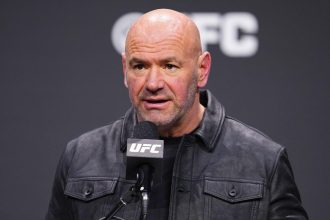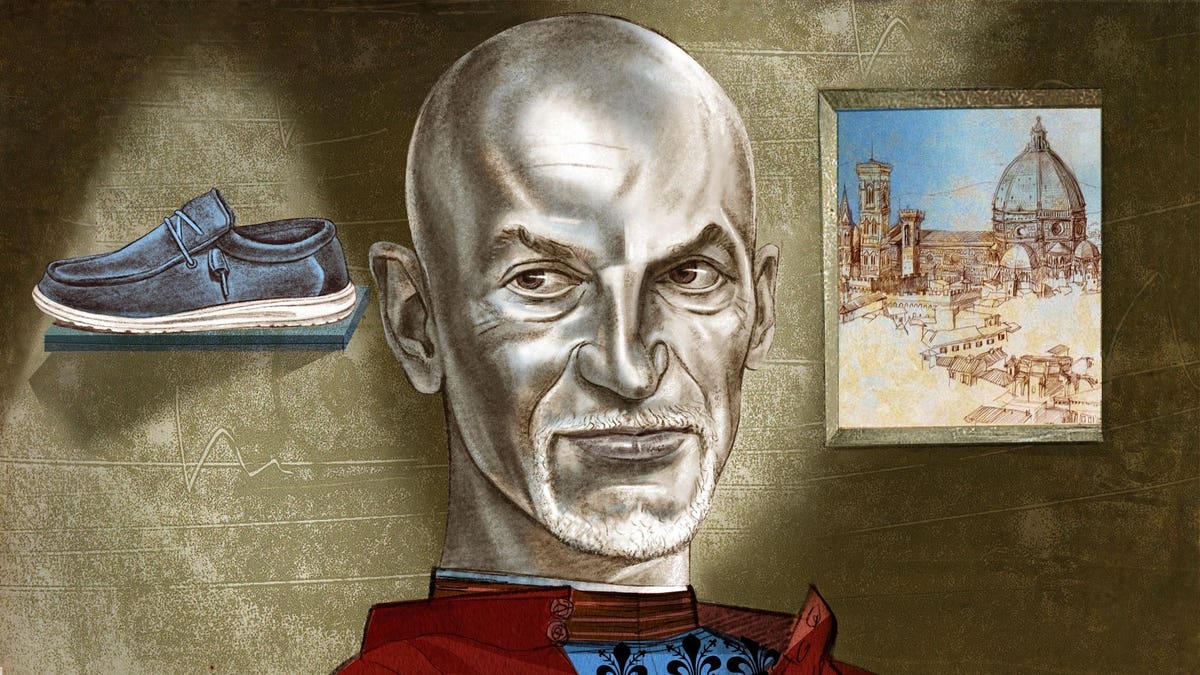Alessandro Rosano’s contrarian playbook for the comfort-footwear company: no financing and minimal marketing. It worked so well he sold to Crocs for $2.5 billion.
By Amy Feldman
Two years ago, Brown’s Shoe Fit Co.’s desperation to stock enough HeyDude shoes to meet the demand reached frenzied levels. The buyers for the 73-store Midwestern chain would get a status report in the morning and try to place a large order. “We would get one-fourth or one-half of what we put in for,” says Adam Smith, senior manager for Brown’s and a former store manager in Jacksonville, Illinois. “The whole nation was trying to get them.”
HeyDude founder Alessandro Rosano, an Italian entrepreneur living in Hong Kong, had tried his hand at other businesses before. But with HeyDude, which makes comfortable slip-on loafers with a so-ugly-they’re-cute look, he hit the jackpot. With minimal investment and almost no marketing, revenue took off, reaching $581 million in 2021, with net profit of $175 million. That December, Rosano agreed to sell the brand to Crocs, the $6.2 billion (market cap) firm whose own ugly-cute rubber clogs are a worldwide phenomenon, for $2.5 billion in cash and stock.
With that deal, Rosano became a billionaire, worth $1.4 billion by Forbes estimates. His business partner and American distributor Daniele Guidi also made a fortune, worth some $650 million after tax by Forbes estimates, after bringing in $787 million in cash from the deal, according to regulatory filings with the Securities and Exchange Commission.
Rosano declined to speak with Forbes, and Guidi didn’t respond to requests for comment. But what the two men were able to build, largely under the radar, is an unlikely success. It stands in stark contrast to many of the direct-to-consumer brands that received lavish amounts of funding and attention from social media during the boom years while failing to become viable businesses. Comfort shoe maker Allbirds, once the darling of Silicon Valley, for example, has seen its market cap collapse from a peak of more than $4 billion after its 2021 initial public offering to just $199 million today as annual sales failed to top $300 million and losses piled up.
Now Rosano, a strategic advisor to the brand under Crocs following the acquisition, has set up a family office to invest his money and work on philanthropy. Crocs is using the brand, which reached $1.1 billion in sales in the latest 12-month period, to add spice to its broader business.
Comfort shoes are having a moment. Crocs, with total sales of $3.6 billion in 2022, has said it hopes to reach $5 billion in sales for its flagship brand by 2026. HeyDude looks poised to help the company soar past that. In 2022, HeyDude was the single fastest growing brand at retail, according to consumer research firm Circana (formerly NPD).
“When we first bought it, we wanted to be clear to people that this was a scale business,” Crocs CEO Andrew Rees tells Forbes. “They hadn’t heard of it, and didn’t know what it was. We put out the $1 billion target, which we knew we could blow past, and we’ve gotten to that easily.”
Rosano, who is in his mid-50s, was a shoe dude long before he came up with HeyDude. He grew up in Tuscany, and studied at Commercio Estero, Pistoia, from 1982 to 1987, though he never received a university degree, according to his LinkedIn profile. Pistoia, a medieval Italian city that’s popular with tourists, is less than 30 miles from Florence, home to Ferragamo and Gucci, in a region known for luxury goods and footwear.
Rosano, who started designing shoes at age 18, had tried other businesses before HeyDude, and had a shoe distributor called Fratelli Diversi. On his LinkedIn profile, where he has just 164 connections, he describes his approach to that company as “acting in a fair and reasonable way, to the people and the environment. Charity acts are also a duty.”
Rosano cofounded a company with Guidi and a third person to make wooden watches called WeWood. Wooden watches are a tough business, and the company was subject to unfair competition litigation in 2011 from a now-defunct watchmaker called Vestal International. Rosano also came up with an idea for wooden clogs with springs in their heels that sold under the name Baldo. None of his early businesses found notable success.
He’d been working in these various businesses for more than 20 years when he founded HeyDude in 2008. In a 2020 interview with Fotoshoe magazine, an Italian industry publication, Rosano’s sister Elena De Martini, who was then CEO of Fratelli Diversi, described how Rosano returned from a trip to China and realized that a modern shoe that was as comfortable as a slipper didn’t exist — and decided to create one.
The shoes Rosano developed, starting with the Wally for men, were lightweight, with elastic laces that didn’t require fastening, and affordable, at around $60 a pair. “The result is perfectly constructed footwear, which is innovative, ultra-light and casual, but with style,” De Martini told Fotoshoe. The shoes were designed in Italy, but the business was headquartered in Hong Kong, where Rosano lives, with production at contract factories in China.
Rosano “is a student,” Crocs CEO Rees says. “He’s a serial entrepreneur. He had a number of entrepreneurial businesses before this that had not been successful. He was looking to improve his chances of success and he admired [Crocs’] focus on simplicity and comfort.”
Though many Italian shoemakers create beautiful shoes for Europeans, Rosano was going for something more mainstream. Not wanting to name the brand after himself as many Italian shoe entrepreneurs would, he came up with HeyDude for its laid-back California vibe, says Rick Blackshaw, who became president of the brand under Crocs. “But all his friends in Italy would call it ‘ey du-day,’” Blackshaw says.
In 2010, Guidi, who has a degree in aerospace engineering from the University of Pisa and runs a consulting and marketing firm called Lever Your Business, joined Rosano to open U.S. operations. The shoes took off, and HeyDude added a woman’s model known as the Wendy, a water shoe and a variety of eco-friendly designs. The shoes were prototypically American looking, easy to wear — and looked like nothing else on the market. Almost all the sales came from the U.S. market, rather than from Europe.
HeyDude sales soared from $20 million in 2018 to $191 million in 2020, according to financials that Crocs shared with investors at the 2022 ICR conference. During the pandemic, as consumers stayed home wearing yoga pants and comfort shoes, the brand fit right in. Its success came despite having no marketing to speak of other than paid search and a commission-based sales team. “It was built on a shoestring,” says Crocs’ Rees.
The brand took off by word of mouth. “In many senses, it’s a pretty remarkable story,” Rees says. “If you were to lay out the playbook that they followed and present it to a set of business executives, they would say there’s no way that this would succeed.”
Footwear analysts and industry watchers were blindsided. “It kind of caught a lot of the industry players by surprise,” says Beth Goldstein, a footwear analyst at Circana. “This brand came up and was all of a sudden having these huge growth rates and buzz. It piqued everyone’s interest.”
Brown’s became one of the earliest larger retailers to stock it after its Muskogee, Oklahoma store manager learned about the brand at a 2012 trade show in Las Vegas. The Buckle, a Kearney, Nebraska-based retail chain with 440 stores, also began carrying HeyDude before the shoe company’s major expansion, in 2019.
“We were known as the top HeyDude retailer,” says Brown’s Smith. “In the pandemic, we didn’t know if we could get products, so we were ordering them by the pallet.” With customers sometimes buying five pairs at a time, however much Brown’s could get its hands on sold out fast. Facebook groups sprung up where people could compare notes, and buy, sell and trade their shoes.
“It was limited quantity and a lot of fun styles and colors, and the price was right,” Smith says. “The customer wanted them so bad it almost didn’t matter what the color was. It was crazy, that’s probably the best way to put it.”
Two days before Christmas 2021, Crocs agreed to buy HeyDude for $2.5 billion, most of it in cash and a smaller amount in stock. Wall Street was not impressed. The shoes that were selling out in the Midwest were scarce on the coasts, where many of the analysts and investors live, and the shoes lacked the cache of hot new sneaker brands like Hoka and On.
“To be honest, when they announced the acquisition, I had never heard of the brand,” says Tom Nikic, a Wedbush analyst, who follows Crocs and has been covering the footwear industry for more than a decade. “It was very much a shock to the system. I think those of us in the New York, Wall Street bubble, we didn’t realize what was happening with the brand.”
Rosano had clearly timed the market well, putting the brand up for sale as it was growing fast and demand for comfort shoes was at a high. Allbirds had gone public in November 2021 gaining a $4.1 billion valuation, making it worth 15 times its sales for that year despite being in the red. By contrast, HeyDude, which was already profitable on higher sales, seemed like a bargain. Crocs CEO Rees says that he’d been following HeyDude for a few years by the time he learned it was on the market and figured it wouldn’t be too difficult to turn it into a $1 billion brand under the Crocs umbrella.
“It was a tightly managed sale process,” Rees says. “They were trying to sell to private equity at that point. We got introduced to the founder and managed to get ourselves inserted into the sales process. At that point, we also started to learn about the compelling financials. It wasn’t completely obvious because they were private, and because they weren’t selling in the traditional channels it wasn’t showing up in the typical data sets.”
With Covid restrictions in place, Rees and Rosano couldn’t meet in person. But Rees figured he didn’t need to meet the HeyDude management team since he planned to replace them. He saw similarities with Crocs: both were polarizing brands that a lot of consumers loved. “I think we got a pretty good deal,” he says. “We weren’t daunted by the large-dollar price tag.”
HeyDude’s strategy of focusing on one style of comfort shoe at a mass-market price was a playbook familiar to Crocs. “Alessandro was really clear that he had modeled a lot of his company on Crocs,” Rees says. “He had been studying Crocs and taking our strategies and incorporating them.”
Crocs also knew what Wall Street didn’t at first: Rosano, helped by Guidi’s U.S. distribution, had built a significant and profitable brand with minimal investment. Though those who know him say that Rosano had been strategic in how he’d built the brand, from the outside it appeared to have burst onto the scene almost by chance.
“We’ve become somewhat acclimated to these newer upstart brands being unprofitable and burning through cash,” analyst Nikic says. “This isn’t Allbirds. This isn’t a money-losing, cash-burning business. It’s actually a very highly profitable company.” Nikic compares the brand’s fast growth to Crocs itself, as well as to Ugg, which built its business on one style of comfort boots.
Since acquiring HeyDude, Crocs has hired Blackshaw, who previously ran Sperry and Keds, as its new brand president. It’s introduced new styles, including sneakers, and is setting up collaborations to give it more buzz. It’s also rejiggering its distribution, expanding to major retailers like Shoe Carnival, Famous Footwear and Academy Sports, and building a new distribution center in Las Vegas to handle its expansion.
The acquisition hasn’t been without a few snags. In the second quarter, HeyDude took a hit — with modest 3% growth as its wholesale revenue dropped 8% year-over-year — and Crocs cut its guidance for the brand for the year from mid-20% growth to between 14% and 18%. One problem: as Crocs cut smaller distributors set up by Rosano and Guidi before the acquisition, some dumped their inventory at lowball prices on Amazon. Wedbush analyst Nikic figures that the problems with gray-market goods should wind down in the coming months once the legacy distributors’ inventory is gone. In its earnings call, Crocs pointed to HeyDude’s 30% increase in direct-to-consumer revenues as a sign of the brand’s strength while it dealt with the “pipeline fill” issues in the wholesale channel. Crocs shares are down 19%, at a recent $100, since the deal was announced.
Marketing muscle and collaborations helped Crocs push its flagship brand, and it intends to do the same with HeyDude. Blackshaw says that the company will “overinvest,” noting it could spend up to 8% of total sales on marketing. Part of the plan: connect with consumers on TikTok and Meta, helped by partnerships with influencers and athletes. A collaboration with hunting brand Mossy Oak launched in June, another with YouTube sports and comedy group Dude Perfect (whose channel has 60 million subscribers) followed in August and a college licensing deal is in the works for this fall. The company has plans for more collaborations, including with Yellowstone, The Big Lebowski, a major beer brand and some toy brands. “It’s a lot of the same playbook that Crocs brought to bear,” Blackshaw says.
Whether the brand will take off on the coasts as it has in the middle of the country remains to be seen. Another risk for HeyDude as it expands is oversaturation. As analyst Goldstein notes, Crocs will need to strike the right balance between growth and introducing new styles that risk cannibalizing its core business. “They almost invented a category,” she says. As the brand expands into other types of shoes, “they need to make their proposition clear,” she says. “Why is a HeyDude sneaker better than anyone else’s casual sneaker?”
Meanwhile, Rosano has his fortune to invest and give away. While venture-backed startups stumble, HeyDude harkens back to an older way of building a company on a smart idea and a shoestring. Perhaps, like comfort shoes, it’s time for that to come back into style.
MORE FROM FORBES
Read the full article here





